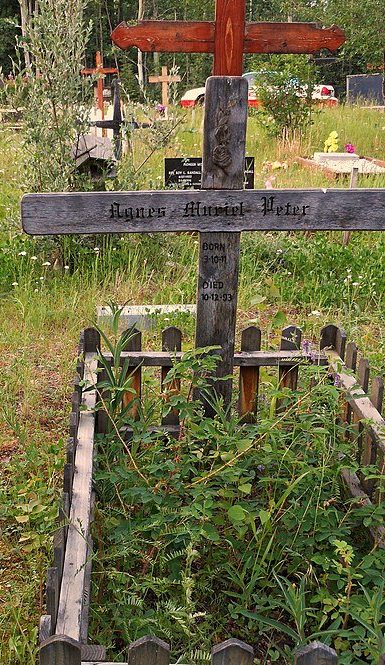Date of Discovery/Date of Establishment & Haunting
Sightings of apparitions within the Birch Hill Cemetery have been happening since the 1930s.
Name & Location
Birch Hill Cemetery houses at least one apparition, the most notable of which is the White Lady.
Physical Description

The Birch Hill Cemetery is a prominent geographical feature in Fairbanks, it rises on the north slope of the city and faces the Steese Highway. It is a peaceful cemetery that is surrounded on three sides by dense woods and the overlooking hill to the city displays seven planters that are in the shape of the Big Dipper–the symbol on the Alaskan flag. It is a very unsuspecting location for a haunting, it’s a beautiful location.
The White Lady appears in an early 1900s era dress and a fancy hat–something that would have been worn during the early pioneering days of Fairbanks. Aside from the White Lady, the apparition who appears most often, there have been reports of a little girl and a little boy who haunt the cemetery on their own.
Origin
The Birch Hill Cemetery officially became the main cemetery in Fairbanks after the Clay Street Cemetery began to quickly fill up–it covers approximately thirty-two acres of the southwest side of Birch Hill and there are still plots available today.
Mythology and Lore
The White Lady has been sighted since 1938 when the cemetery was officially established, along with two apparitions of children.
In 2001, Fairbanks paranormal investigator by the name of Jessie Desmond obtained an electronic voice phenomenon (EVP), but states that they are not necessarily “the result of intentional voice recordings.” He also stated that Paranormal Explorers of Alaska (PEAK) uses this particular cemetery for training and to see if they can capture more information about Birch Hill Cemetery’s resident ghosts. They occasionally capture orbs in their pictures and would hear movements that have no known origin.
In May of 2012, Jessie Desmond collaborated with Neelie Lythgoe and Tony Hernandez members of Investigators of the Paranormal in Alaska (IOPIA) from the Anchorage region; it was during this investigation that they were able to capture a few EVPs as well as a picture of what they believe was an apparition.
Is there anything we missed about Birch Hill Cemetery? Let us know in the comments section below!

Georgia-based author and artist, Mary has been a horror aficionado since the mid-2000s. Originally a hobby artist and writer, she found her niche in the horror industry in late 2019 and hasn’t looked back since. Mary’s evolution into a horror expert allowed her to express herself truly for the first time in her life. Now, she prides herself on indulging in the stuff of nightmares.
Mary also moonlights as a content creator across multiple social media platforms—breaking down horror tropes on YouTube, as well as playing horror games and broadcasting live digital art sessions on Twitch.

